
contraction of the bodies into a well-marked ridge occurs in these rodents in the
sacral region. The sacrum, unlike that of the Muridce, is very compact and
strong, the pleurapophyses being considerably expanded and broadly applied to the
ilium.
In R. badius, Hodgson, only two vertebrae are applied to the ilium, the third
vertebra, although assuming the form of a sacral, is quite free and followed by
another similar segment; so that if these two are regarded as pseudo-sacral, there
are only sixteen caudal vertebrae. In R. prumosus, the third sacral vertebra
partially touches the ilium, and is amalgamated posteriorly with a pseudo-sacral
vertebral element resembling itself; so that, leaving these out of view, there
are 19 caudals. The pseudo-sacral element exists to give support to the thickened
base of the tail. In these respects the skeleton of Rhizomys resembles that of
Siphneus.
Broad transverse processes are well developed on the first five caudal vertebrae, but
they disappear on the seventh, or are represented by a lateral ridge, as far back as the
seventeenth. In R. badius, Hodgson, the transverse processes are distinctly visible as
far back as the ninth vertebra, and their rudiments can be traced even to the thirteenth.
In both these species, these processes are horizontally expanded. Also in both, the
neural canal is perfect on the first four true caudals, and hsemapophyses are developed
from the sixth to the twelfth vertebra. Metapophyses occur from the first to the
fifth caudal, and are well developed. The bodies diminish slightly in length from the
first to the fifth caudal, beyond which they lengthen to the ninth, after which they
again decrease in length. . Eight ribs are directly attached to the sternum, which
consists of seven to eight osseous pieces, the last long and narrow, and occasionally
amalgamating with the smallest of the segments which immediately precedes it. I t is
capped by a broad halbert-shaped xyphoid cartilage resembling the manubrium
in form. The manubrium at its lower end, and the various segments of the meso-
stemum, have each a well-marked epiphysis, and the sternal tips of the rib cartilages
are capped with little ossicles in JR. badius. The clavicle is strong and slightly
outwardly and downwardly curved in its inner half, this head of the bone being large
and rounded, while its acromial end expands, and is flattened from above downwards.
In one skeleton of R. prumosus a small ossicle occurs at the sternal end of the
clavicle. In R. badius there are only six sternal segments and seven sternal ribs.
The manubrium in both species resembles that of Siphneus, and is short and much
expanded, so much so that it is broader than long, and is rounded anteriorly; hence
it is very different from the form of this bone in Bathyergus and Georychus. I t
has a ventral ridge, rather well marked in one female, but nearly obsolete in a male
skeleton. In a female, also, the manubrium is longer than -broad, the lower end or
shaft being well defined, while in a male it is extremely short—nay, almost
absent. Although these two bones are markedly distinct, there can be no doubt
of the specific identity of the two sexes, as they were both killed together.
The manubrium in a female of R. badius has the same form as in the male
of both species.
The scapula of R. prumosus and of R. badius are essentially like that of Siphneus,
and when they are described as only more elongated and broader across the neck of
the bone than in ordinary rats, some idea of their form will have been conveyed. The
acromio-scapular notch is not so deep as in the rat, and the acromion is more
forwardly projected than in that animal and has great expansion.
The os imotmnatum conforms to the Arvicoline type, but the thyroid foramen is
much longer than in Siphneus, and the pubic and ischial bones are weaker and less
expanded, the former being reduced to a narrow rod. There are also certain
remarkable differences between the pelves of these two forms. In R. badius the
thyroid foramen is quite as small as in Siphneus, and the symphysis pubis,
which is rather deep in R . prumosus, is the very opposite in the former species.
In both, anchylosis has taken place through the intervention of a triangular
epiphysis, but, even with the aid of this, the symphysis is not so deep as in JMus
decumanus.
The sexual characters of the pelves of these species are very well defined, the
transverse breadth of the symphysis being much greater in the female than in the
male.
The skull has been described by Temminck, and its general characters indicated
by A. M.-Edwards, so that nothing remains to be said under this head, except
that the periotic bullae are well developed on the posterior aspect of the skull, behind
the auditory osseous tube. Three prominent transverse grooves occur on the anterior
portion of the palate, immediately before the molars, and are succeeded by four much
more obscure furrows between the teeth.
In a young example of R. prumosus, Blyth, the incisor teeth are well exposed,
but none of the upper or under molars have pierced the mucous covering of the
jaw.
The tongue is oblong, and broad at its tip. The oesophagus is rather narrow,
but its mucous lining is thrown into many fine, almost .lamellar-like folds, which
are continued a short way into the stomach along its dorsal wall.
The stomach of R. prumosus when dilated shows a tendency to division into
four sections. The first occurs to the left of the opening of the oesophagus, and is a
Fig. 11.—Stomach of Rhizomys pruinosus, Blyth. Nat. size.